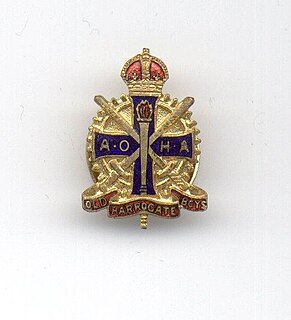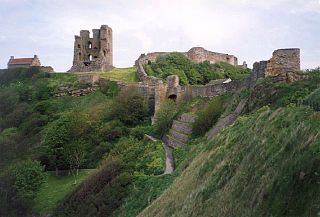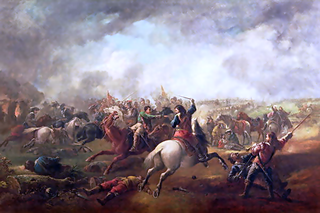 W
WThe Association of Harrogate Apprentices, whose spiritual home is at Harrogate in England, exists to re-unite people in any way associated with the Army Apprentices School, Harrogate, which was renamed the Army Apprentices College, Harrogate in 1965. This includes people such as ex Apprentice Tradesmen (A/Ts), Permanent Staff Members, ex NAAFI employees, Civilian Instructors etc. who served or worked on the establishment itself in such as the YMCA or Salvation Army canteens.
 W
WThe Battle of Old Byland was a significant encounter between Scots and English troops in Yorkshire in October 1322, forming part of the Wars of Scottish Independence. It was a victory for the Scots, the most significant since Bannockburn.
 W
WThe Battle of Boroughbridge was fought on 16 March 1322 in England between a group of rebellious barons and King Edward II, near Boroughbridge, north-west of York. The culmination of a long period of antagonism between the King and Thomas, Earl of Lancaster, his most powerful subject, it resulted in Lancaster's defeat and execution. This allowed Edward to re-establish royal authority, and hold on to power for almost five more years.
 W
WDishforth Airfield is a Royal Air Force/British Army station in North Yorkshire, England. It was an Army Air Corps helicopter base and a Relief Landing Ground for RAF Linton-on-Ouse. The current Unit based at Dishforth is 6 Regiment Royal Logistic Corps. It is located next to the A1(M) at Junction 49 with the A168. Dishforth airfield is built over part of the Great North Road which is also the old A1.
 W
WThe Battle of Dogger Bank was a naval engagement on 24 January 1915, near the Dogger Bank in the North Sea, during the First World War, between squadrons of the British Grand Fleet and the Kaiserliche Marine. The British had intercepted and decoded German wireless transmissions, gaining advance knowledge that a German raiding squadron was heading for Dogger Bank and ships of the Grand Fleet sailed to intercept the raiders.
 W
WHMS Forest Moor was a Royal Navy land base located in Nidderdale in the borough of Harrogate, North Yorkshire, England.
 W
WThe Great Siege of Scarborough Castle was a major conflict for control of one of England's most important stone fortresses during the First English Civil War fought between the Parliamentarians and the Royalists loyal to King Charles I. In February 1645, Parliamentarians laid siege to Scarborough Castle. For five months, they bombarded it, destroying most of the keep, and engaged in bloody fighting before the defenders finally surrendered.
 W
WRoyal Air Force Harrogate or RAF Harrogate, sometimes known as Ministry of Defence (MoD) Harrogate, was the name for two distinct Royal Air Force establishments within the town of Harrogate, North Yorkshire, England. The main site was at St George's in the south-west of the town and was home to a medical training establishment (MTE), supply branch and Women's Auxiliary Air Force (WAAF) training centre. The site was demolished in 1994. The term RAF Harrogate was also applied to the requisition of several hotels in Harrogate town centre which acted as a No. 7 Personnel Reception Centre during World War II. This should not be confused with RAF Menwith Hill, a current RAF base near Harrogate.
 W
WThe Joint Forward Air Controller Training and Standards Unit (JFACTSU) is a training unit located at RAF Leeming in North Yorkshire, England. The unit teaches students from across all three services of the United Kingdom's Armed Forces about Forward Air Control (FAC) including laser designation of targets. Forward Air Controllers working from a forward position on the ground or in the air, direct the action of combat aircraft engaged in close air support of land forces.
 W
WKiplin Hall is a Jacobean historic house at Kiplin in North Yorkshire, England, and a Grade I listed building. It is not far from the River Swale in the Vale of Mowbray. Kiplin Hall is rich in education, in architecture and art, a museum of history, a gallery and provides a biographical record of its past English country house owners. The nearest villages are Scorton, Great Langton and Bolton-on-Swale.
 W
WRoyal Air Force Leeming or RAF Leeming is a Royal Air Force station located near Leeming, North Yorkshire, England. It was opened in 1940 and was jointly used by the RAF and the Royal Canadian Air Force (RCAF). Between 1950 and 1991, it operated mostly as a training base with Quick Reaction Force (QRF) Tornado F3 fighters based there in the latter stages of the Cold War and into the early 21st century. Since 2006, it has become the home of the deployable RAF communications cadre and the home of No. 135 Expeditionary Air Wing.
 W
WThe Battle of Marston Moor was fought on 2 July 1644, during the First English Civil War of 1642–1646. The combined forces of the English Parliamentarians under Lord Fairfax and the Earl of Manchester and the Scottish Covenanters under the Earl of Leven defeated the Royalists commanded by Prince Rupert of the Rhine and the Marquess of Newcastle.
 W
WThe No. 1 Flying Training School is the oldest military pilot training school in the world, currently used to deliver rotary training to aircrew of the British armed forces.
 W
WThe Battle of the Standard, sometimes called the Battle of Northallerton, took place on 22 August 1138 on Cowton Moor near Northallerton in Yorkshire. English forces under William of Aumale repelled a Scottish army led by King David I of Scotland.
 W
WThe York Cold War Bunker is a two-storey, semi-subterranean, Cold War bunker in the Holgate area of York, England, built in 1961 to monitor nuclear explosions and fallout in Yorkshire, in the event of nuclear war.